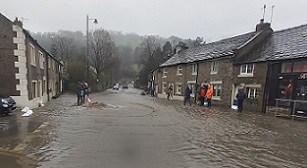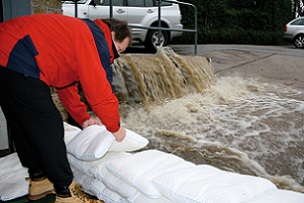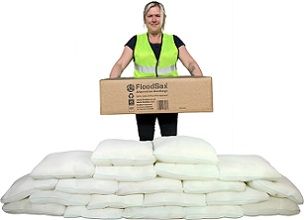 Surface water flooding can cause severe damage and disruption
Surface water flooding can cause severe damage and disruption
 FloodSax alternative sandbags holding back a torrent of floodwater
FloodSax alternative sandbags holding back a torrent of floodwater
 All these 20 FloodSax sandless sandbags came from this one box
All these 20 FloodSax sandless sandbags came from this one box
 Packs of 5 FloodSax are very space-saving to store
Packs of 5 FloodSax are very space-saving to store
Almost 3.5 million properties in England at risk of ‘difficult to predict’ surface water flooding
A hard-hitting report has revealed that almost 3.5 million properties in England are now at risk of surface water flooding.
The National Audit Office has just published the report called Government Resilience: Extreme Weather and in it reveals that across England, of the 5.7 million properties at risk of coastal, fluvial, groundwater or surface water flooding, 3.4 million (60%) are at risk of surface water flooding.
More than 365,000 properties are in areas at high risk of surface water flooding.
This type of flooding happens when rainfall overwhelms the capacity of drainage systems and water flows over the land instead of through the drains but is notoriously hard to predict.
The Audit Office report states: “The Met Office provides short, medium and long range weather forecasts and issues weather warnings when severe weather has the potential to impact the UK, but surface water floods are the exception.
“Currently, it is difficult to predict the precise location, timing and impact of these events due to their localised nature and because they normally happen very quickly.”
The report reveals that it’s unclear who the public should turn to for help in these circumstances, adding: “For some individual risks, such as surface water flooding, it is not always clear who the public should contact when an event occurs.”
The general advice from the Environment Agency is that people are responsible for their own flood protection for homes and businesses as local authorities have no responsibility to provide any anti-flooding measures such as sandbags.
As it is, traditional sandbags are largely ineffective against floodwater and spilt sand adds to the environmental damage which is why many local councils, hospital trusts, businesses and homeowners now use FloodSax (https://www.floodsax.co.uk/) alternative sandbags which are far easier and space-saving to store and quick and easy to deploy in an emergency. It means people have flood protection 24 hours a day, 7 days a week and 365 days a year.
When surface water flooding happens on a large scale it can be catastrophic as it was in July 2021 when widespread flooding affected three-quarters of London’s boroughs with 1,500 properties flooded. It damaged homes, businesses, health infrastructure and transport networks, resulting in estimated insurance losses of £281 million.
The Audit Office says these kind of major events will continue to happen more often, stating: “Evidence is building that heavy rainfall events are becoming more frequent and intense.”
And it says the Government needs to do more.
“Extreme weather events can have devastating consequences for individuals, communities and businesses,” says the report. “Recent events have shown that government must do more to help prepare for and develop resilience to extreme weather. Government needs to increase its focus on reducing these risks and making the system more resilient to the worsening impacts of extreme weather.”
To read the National Audit Office report go to https://www.nao.org.uk/reports/government-resilience-extreme-weather/